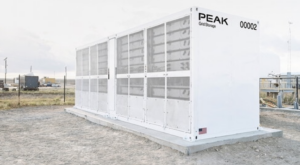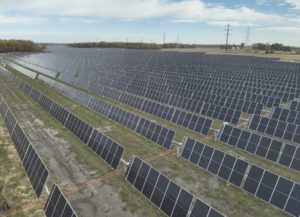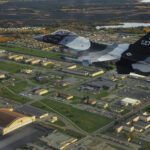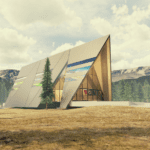The U.S. Air Force has formally reaffirmed its selection of Oklo’s liquid metal-cooled fast reactor to provide nuclear energy at Eielson Air Force Base in Alaska, re-issuing a Notice of Intent to Award (NOITA) for the company’s Aurora Powerhouse following a comprehensive evaluation process. The June 10 announcement, issued by the Defense Logistics Agency Energy on behalf of the Department of the Air Force (DAF) and Department of Defense (DOD), revives a federal microreactor pilot paused in 2023 amid acquisition rule considerations.
Under the anticipated agreement, Oklo would design, construct, own, and operate the Aurora Powerhouse at Eielson, which would deliver both electricity and heat under a 30-year, firm-fixed-price PPA.
The pilot project is central to the Air Force’s microreactor program. Initiated in response to a Fiscal Year 2019 National Defense Authorization Act requirement, DAF’s Microreactor Pilot Program seeks to build and operate at least one licensed microreactor by Dec. 31, 2027, that will deliver power and steam to a defense base under a long-term power purchase agreement (PPA). The department has teamed with the Defense Logistics Agency (DLA) Energy Office to execute the PPA. DAF in October 2021 picked Eielson Air Force Base as the site for its first microreactor in part “due to its resilient power needs for mission assurance, limited access to clean energy, existing energy infrastructure and compatible climate,” the agency said.
While DAF tentatively selected Oklo, issuing a Notice of Intent in August 2023 for its first planned Eielson Air Force Base microreactor, in September 2023, the agency issued a Notice of Rescission “to give further consideration to the agency’s responsibilities” under the governmental acquisition rules. On its website, the Air Force says the procurement process was paused “following a bid protest filed with the Government Accountability Office.”
The pause allowed for additional proposal review, it noted. DAF has noted that as the “ first pilot of its kind,” the microreactor pilot “must undergo significant scrutiny and coordination from all agencies involved. “Unanticipated milestone shifts have not halted our efforts, and the department remains steadfast in our exploration of this innovative technology to assure resilience at mission-critical locations and to meet the evolving challenges of Great Power Competition.”
The Great Power Competition, notably, is described in congressional analyses as a persistent rivalry among the world’s most powerful nations for global influence, status, and resources, and prompted defense planners to prioritize energy systems that are reliable, distributed, and less vulnerable to disruption. A recurring theme in U.S. national security strategy, it has shaped efforts across the Obama, Trump, and Biden administrations to modernize defense infrastructure, including energy resilience initiatives, amid intensifying geopolitical tensions and the growing need to secure mission-critical installations against emerging threats.
Defense Sector Engagement as Key Pillar of Oklo’s Deployment Strategy
For Oklo, the re-issuance marks another notch in its 14 GW pipeline. According to the company’s latest quarterly update, Oklo is now targeting more than 50 commercial deployments, with customers spanning data centers, defense installations, utilities, and industrial facilities.
Oklo’s Aurora Powerhouse is a vertically oriented, compact fast-spectrum reactor derived from the Experimental Breeder Reactor-II (EBR-II) that uses liquid sodium coolant and metallic high-assay low enriched uranium (HALEU) fuel. Introduced initially as a 1.5 MWe microreactor, the Aurora design has undergone significant scaling, first to 15 MWe, and most recently, as unveiled during the company’s fourth quarter 2024 earnings call in March, to 50 MWe and 75 MWe. The company has noted that a 50 MW platform offers flexibility in power output,” delivering between 15 MW and 75 MW, a range that “matches data center architectures well.” The upgrade was achieved with no new technical design risks and maintained a streamlined supply chain and regulatory framework.
Oklo’s first installation—a compact 50-MWe to 75-MWe Aurora powerhouse—will be located at the Idaho National Laboratory (INL), where siting work is already underway. The site, backed by a 2019 DOE site use permit, will also host Oklo’s Aurora Fuel Fabrication Facility, which will produce HALEU metallic fuel recycled from the Experimental Breeder Reactor-II. The INL project is now progressing through Phase 1 of a pre-application readiness assessment with the Nuclear Regulatory Commission (NRC). A full combined license application for the Idaho project expected later this year and commercial operation is targeted for late 2027 or early 2028.
The Eielson Air Force Base project has long been a prospect for the Santa Clara nuclear technology firm, alongside other military projects, given the Aurora’s potential to deliver resilient, distributed, and secure energy. In April, Oklo was one of eight nuclear firms deemed eligble under the June 2024-launched Advanced Nuclear Power for Installations (ANPI) program. Other companies selected include Antares Nuclear, BWXT Advanced Technologies, General Atomics, Kairos Power, Radiant Industries, Westinghouse Government Services, and X-Energy.
The ANPI program, an initiative led by the Defense Innovation Unit (DIU) in partnership with the Department of the Army and DAF is designed to demonstrate and deploy commercial microreactors on select U.S. military bases to support energy resilience and mission continuity. ANPI essentially seeks to field fixed, on-site microreactor systems capable of supplying 100% of critical load requirements. It will promote rapid prototyping through Other Transaction Authority (OTA) agreements, which is a flexible, milestone-based contracting vehicle that bypasses traditional procurement timelines. Regulatory development is intended to proceed via civilian NRC pathways, with support from Department of Energy national labs.
According to Oklo, inclusion in the program validates the company’s technology, but it also “aligns Oklo’s roadmap with national security and clean energy priorities.” As significantly, while it “opens near-term deployment opportunities on defense installations,” OTA contracts could advance “design to prototype to PPA and leverage funding from DIU, any military service, and any agency in the U.S. government.”
Oklo Proposes Novel Fleet-Wide Operator Licensing Framework
Earlier this week, meanwhile, Oklo announced the NRC formally accepted for review its “Product-Based Operator Licensing Framework,” which it submitted in March 2025. The topical report notably outlines a novel framework for licensing operators to the product—the Aurora powerhouse itself—as opposed to individual sites.
Currently in the U.S., most nuclear plant operators—that is, the trained personnel responsible for operating the nuclear reactor—are “licensed to a single facility, and a 24/7 onsite licensed operator workforce is required to ensure that they are available to carry out safety-related actions,” Oklo notes.
But unlike the traditional vendor-designed and utility-operated approach, “Oklo intends to design, own, and operate each powerhouse.” Under Oklo’s framework, “an operator is initially licensed to the common design, the reference product design on which all other subsequent comparable products, or comparable facilities, are based,” it explains in its report. “This approach enables Oklo to be the single accountable entity, responsible for the integrated management of the design, construction, and operation of the fleet of Aurora powerhouses.”
The shift from site-specific to product-based licensing—characterizing an “evolution of the operating fleet licensing framework”—is needed to support “fleet models,” which underpin rapid deployment strategies promoted by policy and market signals, it suggests.
But it also takes into account technology advancements, including the Aurora’s inherent and passive safety systems, along with its high degree of automation, which have significantly reduced the need for human intervention.
“These intentional design choices result in simple operation of the Aurora, which is fundamental to minimizing the reliance upon, or full elimination of, human involvement to uphold safety,” the report says. “As such, the training and licensing of operators can be decoupled from site-specific elements and instead linked to the Aurora product line itself.”
To support the approach, Oklo says it will implement initial, requalification, and continuing training programs, structured around the NRC’s Systematic Approach to Training (SAT) and aligned with NRC Regulatory Guide 1.8 and NUREG-1220. The report delineates roles across a tiered system: licensed “operators” assigned to the Aurora product, remote “monitors,” and on-site “technical support operators” (TSOs), who may be deployed to address plant-specific issues.
Oklo also proposes centralized monitoring and workforce flexibility, allowing operators to move between sites or supervise multiple units remotely. The framework is akin to the Federal Aviation Administration’s (FAA’s) aircraft-specific pilot certification structure, “which issues certificates or licenses to pilots based on particular aircraft types or ratings,” the report notes.
“This parallel is important because the roles of both NRC-licensed operators and FAA-certified pilots are associated with overall public safety in traditionally risk-averse industries,” it argues. “Licensing operators in this way allows similar flexibility to that afforded by aircraft-specific pilots’ licenses and certifications.”
As crucially, the framework is also designed to enhance regulatory efficiency by standardizing operator licensing across the fleet. “The proposed framework establishes a standardized approach to operator training and licensing, designed to be scalable and transferable across multiple facilities using the same reactor product,” it says. “Oklo intends for the NRC’s acceptance of this framework to facilitate a licensing process that can be referenced in future Aurora deployments, thereby reducing the regulatory burden associated with site-specific operator licensing reviews.”
The topical report should serve as a “foundation for a modern licensing framework for licensed operators to meet the demand for deployment of powerhouses at scale, complemented by the safety- and security-by-design profile of the Aurora product line,” Oklo argues. “Traditional facility-specific licensing is not scalable or efficient for fleet deployment. The proposed approach supports efficient training, qualification, and licensing of operators consistent with a standardized, highly automated, and passively safe design,” it says.
Oklo asked the NRC to affirm the report’s suitability for future combined operating license applications and operator licensing programs. Once approved, the topical report may be “referenced in future applications, reducing the need to re-review previously approved material,” Oklo noted. “This regulatory efficiency is central to Oklo’s plan for scalable deployment across its fleet. By strategically submitting topical reports like this one, Oklo is laying the regulatory foundation for faster licensing pathways that support its broader commercialization goals.”
“By combining all aspects of design, construction, and operation into one application, we’re streamlining the path to deployment,” said Jacob DeWitte, co-founder and CEO of Oklo on Tuesday. “Since we build, own, and operate our powerhouses to sell energy directly to customers, it makes sense to align that with a more integrated licensing pathway.”
—Sonal Patel is a POWER senior editor (@sonalcpatel, @POWERmagazine).










